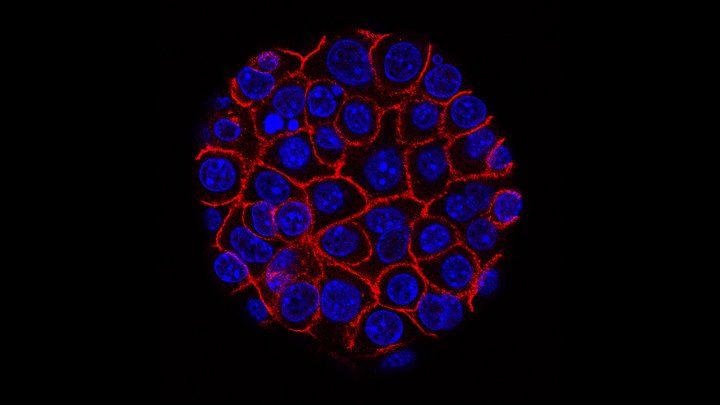Pancreatic Cancer Cells Hijack Muscle Protein to Beef Up Their Metabolism

Pancreatic cancer cells.
Cancer starts with mutations in a cell’s DNA, but new UC San Francisco research shows that the endurance of a tumor relies on its ability to rapidly evolve and adapt to challenges brought about by the environment in which it grows.
“A major obstacle cancer cells must overcome is their incessant need for more nutrients to fuel their accelerated growth,” said Rushika M. Perera, PhD, assistant professor of anatomy in the School of Medicine, who studies metabolic pathways in a cancer known as pancreatic ductal adenocarcinoma (PDA). PDA is an aggressive cancer that took the lives of Supreme Court Justice Ruth Bader Ginsburg and Congressman John Lewis, as well as 47,000 other Americans last year.
One hallmark of the PDA cells Perera studies is that they grow and divide more quickly than normal cells. This rapid growth is tied to their increased ability to scavenge nutrients wherever possible. Some of these nutrients are processed within cell structures called lysosomes – bubble-shaped organelles that are bound by a membrane and hold enzymes tasked with digesting and recycling these nutrients.
She is particularly interested in the lysosomes of PDA cells because they function at heightened capacity and help process the larger quantities of the fuel necessary to spur cancer cell growth. In doing so, PDA lysosomes must also have specialized safety mechanisms in place to ensure that their increased workload doesn’t lead to excessive damage.

Rushika Perera, PhD. Image by Susan Merrell
As reported in the March 8, 2021 issue of Nature Cell Biology, Perera cultured cancerous and non-cancerous human pancreatic cells, extracted the lysosomes, and determined which proteins were unique to cancer lysosomes. She was surprised to find that a protein called myoferlin, which isn’t normally found in pancreatic cells, was plentiful in the cancerous lysosomes.
Myoferlin typically only appears on the surface of skeletal muscle cells, where it helps them weather mechanical stress. In PDA cells, Perera said, the protein seems to strengthen the lysosomal membrane so that it can withstand some bulging without tearing open.
“The PDA cells are essentially hijacking a protein that’s usually only used by skeletal muscle cells,” she said, “and then they direct the protein not to the cell surface, where it’s found in muscle cells, but onto the lysosomal membrane, where it’s needed.”
It’s not clear what triggers the cancerous cells to produce myoferlin, said Perera, but the protein seems to be essential for their survival. When she and her team removed myoferlin from the lysosomal membrane in PDA cells, the organelles broke down, leading to cell death.
Given the lack of treatments and poor prognosis for PDA patients (most survive only 10 months after diagnosis), Perera said there’s an urgency to understand the biology of the cancer in more detail in order to design new targeted drugs. Her next steps are to sort out how myoferlin gets directed to the lysosomal membrane and the mechanics of how it prevents the membrane from tearing under stress.
Perera said her findings illustrate the importance of looking at such adaptations when considering approaches to reining in cancer, and she notes that researchers are becoming more interested in strategies that cancer cells use to protect their organelles and cell function.
“Incorporating myoferlin into the membranes of lysosomes is only one way that cancer cells can adapt and keep themselves going,” she said. “Our work opens the door to understanding the phenomenal array of mechanisms that diseased cells can use to protect themselves, many of which we still haven’t yet discovered,” she said. “I mean, who would have thought that a muscle protein was so important to the survival of a pancreatic cancer cell?”
The University of California, San Francisco (UCSF) is exclusively focused on the health sciences and is dedicated to promoting health worldwide through advanced biomedical research, graduate-level education in the life sciences and health professions, and excellence in patient care. UCSF Health, which serves as UCSF’s primary academic medical center, includes top-ranked specialty hospitals and other clinical programs, and has affiliations throughout the Bay Area. UCSF School of Medicine also has a regional campus in Fresno.